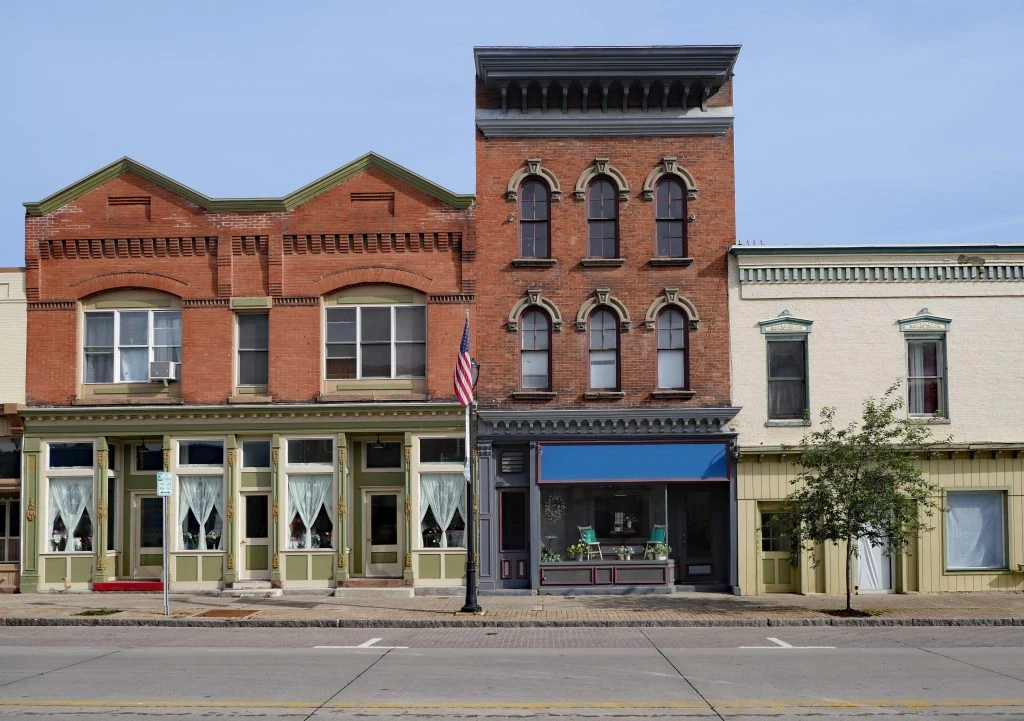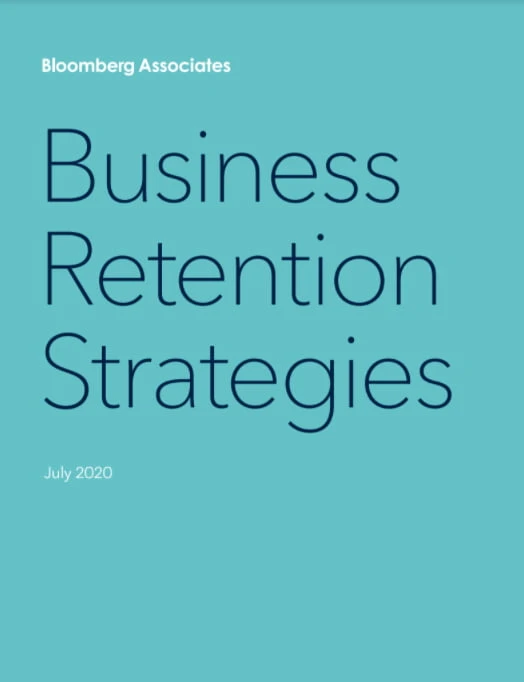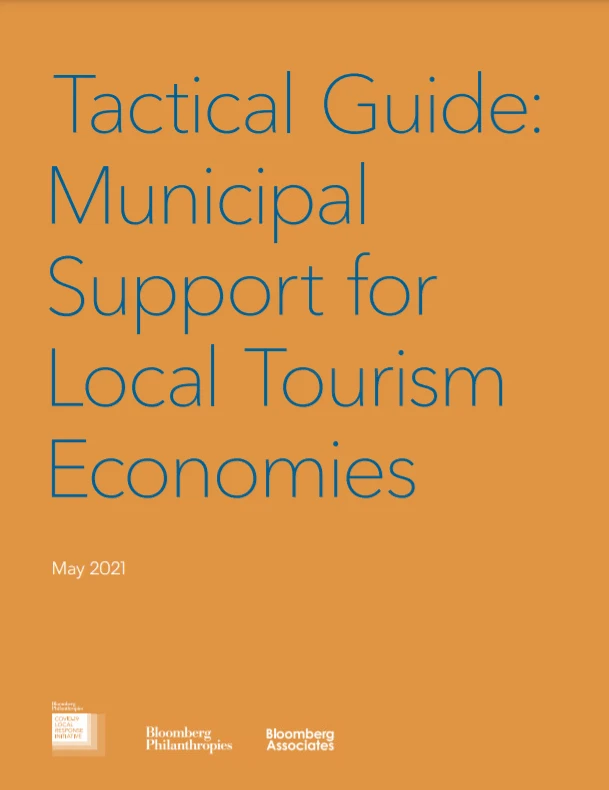COVID-19 Economic Response and Recovery
Create a Business Retention Advisory Council and Key Accounts Team

Consider the following stakeholders for an advisory council: city/ county and/or state economic development organization, metro chamber of commerce, retired business executives, city and/or state government official, utility representative, education entity, financial institution, professional services company, business owner/operators. Council members should be chosen for their skills, knowledge, expertise and connections.
Staff your key accounts team with key account managers from your economic development organization, chamber of commerce and/ or government officials. Each target business should have a key account manager, who is always available for the business to contact and should touch base at a regular interval (every 3–6 months). Ideally, the key account manager would have actively worked to land the project and has a relationship with senior management of the business.
It will also be important for the key accounts team — with the advisory council’s help — to build meaningful partnerships with organizations which can make a significant contribution to the program’s success, for example the Mayor/ city administrator, chamber of commerce, state economic development agency, local economic development organization, and other supporting organizations, which are willing to collaborate for the greater good.
Learn more about Business Retention Strategies
COVID-19 Economic Response and Recovery
Consider Additional Sources of Funding and Cost Savings
Action
Support industry coalitions which are building a case for additional aid for tourism businesses, as well as American Rescue Plan Federal replacement revenues for lost hotel tax revenues. (For example, provide access to data/evidence and connections.)
Support local, small businesses — particularly micro, minority-owned and unbanked businesses — to apply for direct aid and technical assistance.
Encourage industry players to pool funding and resources (for example, to purchase PPE or for marketing activities).
Explore opportunities to make cost cutting savings by partnering, delivering through others, and/or merging operations.
Why
In the future, many DMOs will have to manage with smaller budgets, and many local businesses have bled cash during lockdowns. As a result, everyone will need to identify savings, find new ways to collaborate, and pool resources for programming which benefits all.
Background
The pandemic has placed enormous budget pressure on municipal governments, threatening deep and potentially lasting cuts to programming. The U.S. Travel Association and Tourism Economics estimates that the depressed level of travel spending has caused a loss of $64 billion in federal, state, and local tax revenue since March 1 2020.
Many DMOs and convention centers rely on hotel tax revenues for a large share of their operations. From 2020 to 2025, hotel tax revenues in 25 largest US cities are estimated to fall short of 2019 levels by approximately $6.1 billion.
As a result, DMOs and municipal governments may need to refinance debt that is repaid by hotel tax revenues if reserves are insufficient to cover existing debt service obligations. They may also need to temporarily close convention centers, delay convention center expansion projects, and/or reduce DMO operations unless American Rescue Plan funds can be used, alternative revenue sources can be found, or hotel tax revenues recover.
Some cities are implementing temporary measures. For example, McCormick Place Convention Center in Chicago has traditionally accessed taxes from restaurant and hotel sales, car rentals and airport departures, as well as the State of Illinois’ sales tax. When sales taxes dropped in 2020, the Center tapped into a reserve fund to help pay back its debt. In 2021, it plans to refinance its debt to replenish the fund.
Guidance
Bloomberg Associates has created a tactical guide on new sources of operating funding for economic development programming, some of which may be relevant for programming to support your tourism economy.
Cities may also want to look at alternative DMO funding models, which do not rely on hotel or sales tax.
For example, Julie Heart from CFO by Design has suggested a shared-services model between local convention bureaus, Chambers of Commerce and economic development councils.
Under this model, the convention bureau would develop branding and creative services for the city, the Chamber would educate local businesses on the value that tourism and meetings bring to the destination, and the economic development council would work with the convention bureau to attract industry, businesses and talent to the city.
Other cities, such as London (UK) have gone further, merging their agencies to better promote the city with one voice while achieving significant cost savings. In 2011, London merged its tourism and convention bureau with its business attraction, international student attention, and small business support programs, generating more than £2m initial savings.
A similar model was followed in Topeka, Kansas. The Greater Topeka Partnership combined the economic development agency, Chamber of Commerce, BID and tourism agency, which combined office space and eliminated redundancies (such as multiple contracts with the same vendor). The organizations also coordinated their plans and activities to create jobs and attract visitors.
We are also seeing more partnership working between local and state/national DMOs. For example, Destination Canada and Destination BC announced a partnership last year to help local DMOs market domestically.
Learn more about the Tactical Guide
COVID-19 Economic Response and Recovery
Build Your Data Capacity and Digital Presence
Action:
Build tools and partnerships to help you better understand and boost your online presence with target travelers.
Why:
The pandemic has increased digital screen time. More and more travelers are searching for travel inspiration online, and they increasingly expect technology to provide them with more personal control over their travel experiences.
In a recent poll, 95% of travelers from 28 countries said they spent free time during the pandemic looking for travel inspiration, with 38% looking at potential destinations at least once a week.
This has created opportunities for destinations to use aggregated, anonymized data, and/or to ask travelers for permission to access personal data to personalize marketing campaigns and offerings — which should achieve significantly higher open and click through rates.
Background:
As we adapt to the new reality, destinations need to stimulate and capture the little demand that currently exists, and be ready to capitalize on pent up demand as things return to “new normal.”
Messages and promotions will, therefore, need to be relevant, given the behavior that specific consumers have developed during the pandemic. Has a traveler flown yet? Stayed in a hotel yet? Left their home state yet? Are they nervous to do so? What are their biggest concerns?
Despite consumers saying that they are concerned about the privacy of their personal data, there is plenty of evidence that they are very willing to trade personal information for benefits or rewards — particularly monetary compensation, promotion incentives, and discounts based on their interests, and convenience and speed in using services.
Personalized marketing technology has advanced rapidly in recent year and many brands — from Amazon29 to Target30 — have used behavioral targeting and predictive modelling to take marketing to a whole new level.
Travel and tourism industry examples of data tools to help personalize marketing, target sales, and/or enhance customer service, include:
- London Heathrow Airport’s Connected Spaces project, which enables the airport to better identify, understand, and engage with customers across all touchpoints of the airport.
- Virgin Hotel’s Customer Wi-Fi and Business Intelligence platform, which allows the hotel to acquire new customers, target sales offers, build loyalty with personalized communications, create campaigns based on contextual data, understand customers better through new insights, and refine audience segmentation.
- Singapore National Research Foundation’s Virtual Singapore software, which can analyze visitor movements, with multiple applications for destination management.
- Lufthansa’s Big Data Engine, which allows the airline to offer personal services, as well as upsell to customers.
From our experience, very few cities or DMOs have the resources or know how to imitate leading retail or tourism players.
Fortunately, there are specialist tourism, ad-tech agencies, such as California’s Sojern and Adara, which offer digital travel marketing solutions and can deliver tourism marketing campaigns which microsegment audiences at scale.
Some DMOs, however, do have ambitions to become truly data-driven organizations, by building data solutions specifically for their destinations.
Bloomberg Associates has provided past advice to governments and DMOs which are seeking to understand each visitor — their behaviors and expectations — in order to provide a personalized experience.
It has been our experience that they have often struggled to progress these goals beyond individual marketing campaigns which offer personalize content. This is largely due to aversion to risk, limited technical skills, and/or legacy technology stacks.
Cities and DMOs should, therefore, approach this topic with their eyes open.
Below, we share some principles for DMOs that are thinking to build destination data platforms, which are drawn from our own consulting experience. We have also included, at Appendix 3, an infographic, which shows what an end-to-end data management platform solution could look like.
Case Study
Singapore’s Tourism Analytics Network (Stan)
Singapore’s Tourism Analytics Network (Stan) is an analytics platform for its DMO and tourism organizations, which contains monthly tourism data sets and visualizations.
It was created in 2016 for the Singapore Tourism Board (STB), initially as an internal management tool. The STB subsequently opened it to the general public. The platform contains top line statistics, which are available to the general public, and more in-depth features, which are available to selected industry organizations with a login account. The platform is currently free for all users.
Its data sets and visualizations include:
- Visitor arrivals and seasonality
- Visitor segmentation and demographics
- Visitor spend (what visitors are buying, how much they are spending, what their interests are, etc.)
- Hotel statistics; and
- Visitor satisfaction rates.
The STB uses the platform to understand its visitors and to encourage industry collaboration. It has also developed a self-assessment tool for industry players to diagnose their current state of transformation and provide targeted insights to take action to stay relevant and thrive.
The STB is currently adding new features to the platform, which include:
- A data marketplace for industry players to share and consume tourism-related data; and
- A co-creation space equipped with predictive tools, for industry collaboration on data analytics projects.
How To Adopt This Approach:
Engage a local partner to create, initially, an internal dashboard/insights platform. E.g., Start by talking to your local National Neighborhood Indicators Partnership partner (if you have one), a local university, or community college.
Explore how you can complement existing data sets with third-party (including private sector) data and closer-to-real-time data.
Engage local industry players to understand what insights would help them to thrive.
Recognize that different tourism organizations will have different levels of tech and data literacy, so prioritize a very simple and intuitive user interface.
Distribute the platform for beta testing and get feedback as quickly as possible.
Once your platform has been released, take the time to publicize it and train industry organizations for different use cases. Continue to host training sessions as the product evolves.

Do:
- Do recognize that a data platform, particularly one which enables content personalization, will require money, time, and technical skills. It may also require upgrades to, or the replacement of, your tech stack (e.g., visitor data collection system, CRM, content database, suggestion engine, and visitor communication channels — website, mobile app, chatbot).
- Do talk to your local public transit operator, which may be more advanced, and already using real-time traveler data.
- Do recognize that a solution for a destination will be more complex than a solution for an airport, shopping mall, or hotel. However, the increased return on investment, in terms of reach, engagement and conversion, will
also be significant. - Do engage a specialist database marketing company to build your solution, and do not try to build it on a public sector technology stack.
- Do hire a dedicated project manager who has the technical capability to manage your vendor and oversee its work.
- Do seek a costed menu of options before selecting your preferred solution.
- Do run a pilot for proof of concept and to demonstrate that the expected return on investment is real.
- Do seek legal and policy advice before handling personal data — not just to comply with data protection laws, but also not to adversely affect your government’s/destination’s reputation.
Don’t:
- Don‘t try to turn your DMO into a tech development company, which will never be your core strength.
Learn more about the Tactical Guide
COVID-19 Economic Response and Recovery
Become an Information Clearinghouse and Provide Access to Contacts and Networks
Action
Strive to become a trusted adviser to the employer, as well as a single repository of the information and technical assistance that the employer needs. It should be your aim to be able to introduce the business to anyone in the city, find the answer to any of the business’ questions, and identify the opportunities which can support the business’ local operations. A good way to build a relationship is to educate your employers about federal and programmatic dollars which they can access.
Provide regular networking opportunities for local employers, for example, business roundtables with the Mayor/council members/senior officials, networking lunches, and meetings with local banks and university heads, etc.

Learn more about Business Retention Strategies
COVID-19 Economic Response and Recovery
Address Target Employers’ Needs by Sharing Information, Providing Support and Finding Solutions to Problems
Background
Site visits should be followed up within 24 hours with a communication outlining how you plan to address the employers’ needs — for example, by sharing information and advice, unblocking an obstacle, and/or providing access to assistance, contacts, networks and/or a sales opportunity.
Examples of Supports Include:
- Information: Providing access to economic data and demographic information
- Providing information and advice on the availability of appropriate buildings and sites
- Providing information and assistance on regulations and permits
- Technical assistance: Providing access to technical assistance programs, e.g. to increase firm efficiency
- Providing support/funding to restructure for a post-pandemic economy
- Access to funding: Providing access to tax exemptions and incentives for retention/expansion
- Workforce training: Providing access to training dollars to train the business’ employees
- Access to talent: Providing opportunities to shape talent pipeline plans
Providing access to graduate students - Innovation support: Facilitating research collaborations
- Facilitating support for product development, innovation and/or collaborations with tech startups
- Supply chain support: Facilitating access to local suppliers (and supporting those suppliers to deliver scale and quality)
- Access to markets: Providing marketing assistance (e.g. use your website and social media channels to promote local businesses)
- Identifying opportunities to sell goods and services to the city
- Providing support to enter new sales channels (e.g. overseas)
- Lobbying: Making a case to city officials to reform/relax land use planning, zoning and/or building regulations, local ordinances and/or permitting rules where these are no longer fit for purpose for a pandemic/post-pandemic economy
- Helping local management make the case to HQ why the local office/ plant should be retained, or expanded
- Lobbying state and federal officials for supportive policies and programming
- Corporate social responsibility opportunities: Identifying ways in which the business can support the city’s crisis response, for example, by connecting a business to charities and nonprofits; or asking it to provide pro-bono training or technical assistance for small business owners.
Benefits of a business retention visitation program:
- Identification of at-risk companies
- Identification of business issues and concerns impacting competitiveness
- Updating of data including employment levels and recruitment/ retention issues
- Discovery of future plans for contraction, closing, or expansion and capital investment
- Establishment of an ongoing communication process
- Making employers aware that they are a valued part of the community
- Indicating the willingness of the city to work with firms and solve problems
Use a CRM tool, such as free HubSpot, or Salesforce for Economic Developers to manage your relationship with the employer, and record the program’s impact.
Consider asking around to see which CRM tool your state and/ or regional EDO partners use. By using the same platform as key partners, it may be easier to share and integrate data.
Learn more about Business Retention Strategies
Action:
Work with local communities to develop marketing campaigns which will give residents and nearby travelers reasons to explore your destination’s “off the beaten track neighborhoods”.
Why:
Travelers’ inclinations and behaviors have been transformed because of the fear of getting infected, trapped, or quarantined. As a result, travelers are looking for opportunities to travel to destinations which are closer to home, familiar, predictable and low risk.
Background:
Travel restrictions to and from countries combined with insecurity regarding crowded airport terminals and flights mean that domestic tourism is likely to recover much more quickly, and local holiday options and weekend staycations are increasing in popularity.
Even before the pandemic, the U.S. domestic tourism market was worth nearly U.S.$ 1 trillion. Since 2020, many destinations have focused on growing domestic tourism, including programs to encourage residents to explore their own cities. These include initiatives focused on marketing and promotion, as well as financial incentives.
Examples:
- As part of its All In NYC campaign, New York City’s NYC&Co created weekend neighborhood guides, such as Exploring Black-Owned Harlem, and a Tour Your Own City program, to encourage residents to explore different parts of the city.
- London created “Because I’m a Londoner” citywide campaign to inspire a recovery in consumer spending by encouraging residents to responsibly rediscover the capital and support local businesses, organisations, areas and places. It also created the London Alliance, a community of 500+ businesses, which were provided with free assets to use as part of the campaign. The campaign increased consumer confidence by 5% and led to a 43% uplift in frequency of going out.
- Toronto, Canada created a program called Bag of Toronto, which encouraged residents to purchase goods from different city neighborhoods. Cleveland created a similar program, called Cleveland in a Box.
- Visit Houston marketed coupons and deals on its Houston Experience Marketplace to local residents. The marketplace is delivered in partnership with Bandwango’s technology platform, and generates income for the DMO.
- Geneva, Switzerland gave overnight visitors gift cards preloaded with 100CHF (~$110) which could be used at a range of hotels, restaurants, cafes, bars and on activities around the city.
- Explore France partnered with cities to create a campaign #CetÉtéJeVisiteLaFrance, to inspire its citizens to explore 21 city-regions across the country.
- Little Rock convention bureau partnered with the local historic association to create a series of audio guides for walking and driving tours. The tours have been enjoyed by students doing remote learning and will be marketed for visitors to come.

Guidance:
Bloomberg Associates has created a “how to” guide to create a neighborhood tourism campaign, which can be found at Appendix 2.
We have also created a “how to” guide to segment your target audience, which can also be found in the Appendix.
We are not, therefore, able to share a case study of emerging good practice by a DMO at this time.
Learn more about the Tactical Guide
COVID-19 Economic Response and Recovery
Create a Database of Existing Employers, to Which You Will Target your Efforts
Your business retention program will focus on:
- Large corporate employers – which provide major capex and job creation numbers for your economy
- Smaller and medium sized businesses – which make up the baseline of your city’s economy.
Your target employers should be businesses which create large numbers of good and promising jobs for local residents (and, from an equity perspective, jobs that don’t require bachelor’s degrees).
Brookings Institution defines “good and promising jobs” here. These are jobs that pay the median wage for sub-baccalaureate workers, and provide stable employment and employer-sponsored health insurance. (US metro statistical area median wage figures can be found here.)
“Good job” employers are likely to be concentrated in maintenance, construction, production, transportation, management, business, computer, engineering and healthcare industries.

You may also want to target:
- Businesses which have received incentives in the past
- Businesses which are likely to thrive in a postpandemic economy and during a significant economic downturn (e.g. because of limited disruption to their personnel, operations, supply chains or revenue; or demand for their goods/ services is relatively inelastic; or their products might need to be “near-sourced” in the future)1
- Businesses in industries in which the city has a competitive advantage (for US county location quotient data, see here)
- Businesses which are in emerging industries, or are doing unique and innovative things, which may be growth opportunities for your city; and/or
- Businesses in industries which have a lower share of tasks that are susceptible to automation (see here)
- Businesses in priority neighborhoods: Pay special attention to small businesses that employ between 10 to 99 employees, which are often major drivers of local job growth
Many consulting firms, ratings agencies, think tanks and academic institutions are publishing research and insights on this topic, for example, Moody’s Analytics, McKinsey, Avasant. Their work is constantly being refined as the crisis progresses and better data becomes available.
If you have limited resources, segment your employers as follows:
- 50x priority 1 employers, which will be account managed
- 200x priority 2 employers, which will receive surveys and lighter touch support.
Choose whether to separate out tourism and hospitality businesses, if they can be supported better by your local destination marketing organization/convention bureau.


